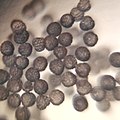| Philippine violet | |
|---|---|
 | |
| Scientific classification | |
| Kingdom: | Plantae |
| Clade: | Tracheophytes |
| Clade: | Angiosperms |
| Clade: | Eudicots |
| Clade: | Asterids |
| Order: | Lamiales |
| Family: | Acanthaceae |
| Genus: | Barleria |
| Species: | B. cristata |
| Binomial name | |
| Barleria cristata | |

Barleria cristata, the Philippine violet, bluebell barleria or crested Philippine violet, is a plant species in the family Acanthaceae.
Contents







